Birds
Media

Species Types
Scientific Name
Quiscalus quiscula
Description
The common grackle makes “a mistake . . . in trying to sing,” a prominent birder once wrote of its kree-del-eeeeks and chlacks. Yet its iridescent purples, blues, and bronzes please the viewer despite the harshness of the voice.
Media
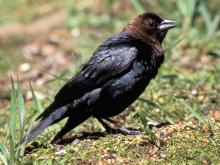
Species Types
Scientific Name
Molothrus ater
Description
The brown-headed cowbird never builds a nest of its own. Instead, it lays eggs, one at a time, in the nests of other birds. Each cowbird is raised by unwitting foster parents.
Media
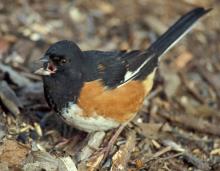
Species Types
Scientific Name
Pipilo erythrophthalmus
Description
Often heard before seen, the eastern towhee scratches vigorously on the ground in fallen leaves and sings its telltale “drink your teeeeee!” and “chewink!”
Media
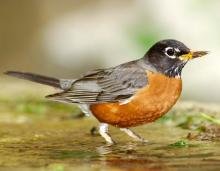
Species Types
Scientific Name
Turdus migratorius
Description
A well-known symbol of springtime, this bird hunts on the ground for earthworms and insects. The robin’s colorful rusty-red breast is as welcome in spring as its cheerful singing at dawn and dusk.
Media
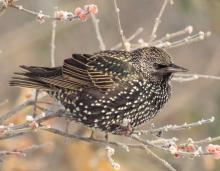
Species Types
Scientific Name
Sturnus vulgaris
Description
Few Americans love this bold nonnative bird, purposefully introduced to our continent in the late 1800s and now abundant throughout our country.
Media
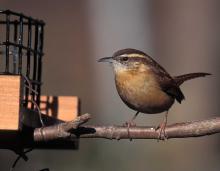
Species Types
Scientific Name
Thryothorus ludovicianus
Description
Male Carolina wrens sing a loud “teakettle, teakettle, teakettle.” This species is a rich reddish brown with white throat and eyebrow. Pairs hunt furtively in brushy tangles, tails cocked upward.
Media

Species Types
Scientific Name
Cardinalis cardinalis
Description
The male northern cardinal is a bright red bird with a head crest and black mask. An excellent singer, this familiar backyard bird is beloved by many.
Media

Species Types
Scientific Name
Sayornis phoebe
Description
Eastern phoebes often build their mud-and-plant nests on the side of a house, just under a roof or other overhang. These small flycatchers repeatedly cry out their own name: “FEE-bee! FEE-bee!”
Media

Species Types
Scientific Name
Bombycilla cedrorum
Description
Sleek, crested cedar waxwings gather in large, relatively quiet groups to eat berries from shrubs and trees. The voice is a high-pitched, whizzy trill.
Media

Species Types
Scientific Name
Charadrius vociferus
Description
The killdeer is a familiar “shorebird,” but we usually don’t see it near shores! Killdeer prefer open, flat, rather dry areas with short grass, including flooded crop fields, lawns, and sports fields.
See Also







Media

Species Types
Scientific Name
Hemaris diffinis
Description
The snowberry clearwing is a moth that confuses people because it looks like a bumblebee and flies like a hummingbird!
Media

Species Types
Scientific Name
Hyles lineata
Description
The white-lined sphinx moth sometimes confuses people because it flies, hovers, and eats from flowers like a hummingbird. The adults often fly during daylight hours as well as in the night and are often found at lights.
Media

Species Types
Scientific Name
Darapsa myron
Description
The Virginia creeper sphinx moth is common in woods and brushy areas and comes to lights at night. The larvae eat Virginia creeper and grape leaves.
Media

Species Types
Scientific Name
Perimyotis subflavus (formerly Pipistrellus subflavus)
Description
Tri-colored bats, formerly called eastern pipistrelles, are relatively small and look pale yellowish or pale reddish brown. The main hairs are dark gray at the base, broadly banded with yellowish brown, and tipped with dark brown.
Media

Species Types
Scientific Name
Myotis grisescens
Description
Gray myotises are difficult to distinguish from other mouse-eared bats. A key identifying feature of the gray myotis is that its wing is attached to the ankle and not at the base of the toes. It’s an endangered species.
Media

Species Types
Scientific Name
Myotis lucifugus
Description
The little brown myotis (little brown bat) is one of our most common bats, but populations are declining. White-nose syndrome has taken a heavy toll in northeastern states. This species is now listed as vulnerable across its range.
Media

Species Types
Scientific Name
Myotis sodalis
Description
The Indiana myotis, or Indiana bat, summers along streams and rivers in north Missouri, raising its young under the bark of certain trees. It is an endangered species.
About Birds in Missouri
About 350 species of birds are likely to be seen in Missouri, though nearly 400 have been recorded within our borders. Most people know a bird when they see one — it has feathers, wings, and a bill. Birds are warm-blooded, and most species can fly. Many migrate hundreds or thousands of miles. Birds lay hard-shelled eggs (often in a nest), and the parents care for the young. Many communicate with songs and calls.





















